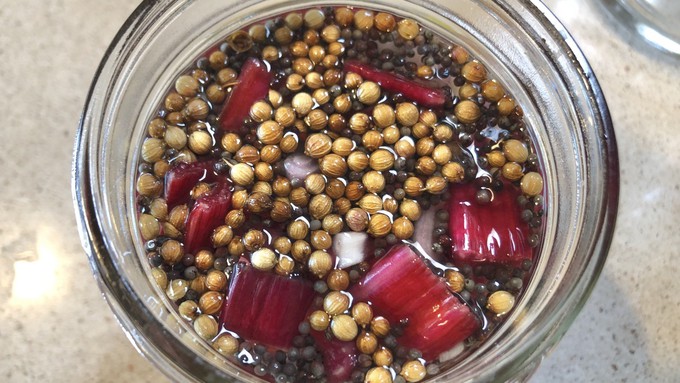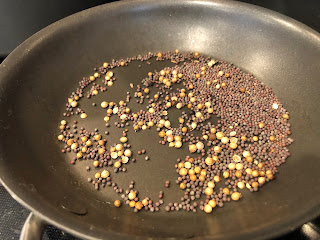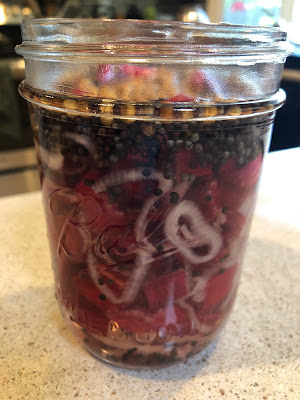
Recipe: Rainbow chard stalks produce a pretty snack

Red chard stems and spices are covered in brine, ready to chill in the refrigerator. Kathy Morrison
In my continued quest to not let anything go to waste these shelter-at-home days, I went hunting for recipes to use chard stalks. There had to be something out there that used the long, pretty, celery-like stems from my never-say-die chard plant .
I hit on pickles, and have tried a couple of recipes now. The one here (adapted from an Epicurious recipe) is my favorite so far, with mustard seeds, coriander seeds and a shallot -- adding a lot of flavor to the gorgeous but rather bland chard stalk pieces.
These pickles aren't as fast as our blog's famous Zapped Pickles , but they still go together pretty quickly. No canning is involved, since they pop into the refrigerator, but make sure to have a sterilized pint jar ready to put them in. (The dishwasher works just fine.) Then chill and enjoy!
Refrigerator chard stem pickles
 |
|
A few ingredients are all you need to make a pint of pickles.
|
Makes 1 pint
Ingredients:
4 large stalks from chard, washed and trimmed
1 small shallot, thinly sliced
2 tablespoons kosher salt
1 tablespoon brown mustard seeds
1/2 tablespoon coriander seeds or caraway seeds
A couple of black peppercorns, optional
Brine:
1/2 cup unseasoned rice vinegar (champagne vinegar, apple cider vinegar or white wine vinegar also work, but avoid distilled white vinegar)
1/4 cup granulated sugar
1/2 cup water
Instructions :
 |
| Toast the seeds before using in the pickles. |
Slice the chard stems into 1/2-inch pieces, removing any outer strings that come loose as you cut. You should have about 2 cups of pieces. Combine the chard pieces with the shallot slices and the salt in a colander set in the sink or over a large bowl. Let stand 1 hour.
About 15 minutes before the chard stems are ready, toast the mustard seeds and coriander seeds (and peppercorns, if using) in a small, dry skillet over medium heat. Stir often. In about 2 minutes, the mustard seeds will start to pop open. Remove the pan from the heat before too many pop, and let the seeds cool.
To make the brine, combine the vinegar, sugar and water in a small saucepan, and bring to a boil. The sugar should dissolve quickly. Remove pan from heat.
 |
|
After cooling the brine-covered pickles for a few minutes,
cover them and refrigerate overnight.
|
Rinse the chard stems/shallot combination well, and drain well. Pack the stems, shallots and cooled seeds in a sterilized (washed in hot soapy water or in dishwasher) pint jar. Pour the brine into the jar over the vegetables. Let the mixture cool slightly, then cover the jar with a tight-fitting lid and place it in refrigerator. Chill overnight before serving. Gently shake the jar occasionally, if you think of it, but that's not a must.
The pickles will keep in the refrigerator about a month. If you used red chard stems, the lovely color will fade eventually, but the pickles likely will be consumed before that happens.
Comments
0 comments have been posted.Sacramento Digs Gardening to your inbox.
Sites We Like
Garden Checklist for week of July 21
Your garden needs you!
* Keep your vegetable garden watered, mulched and weeded. Water before 8 a.m. to reduce the chance of fungal infection and to conserve moisture.
* Feed vegetable plants bone meal, rock phosphate or other fertilizers high in phosphate to stimulate more blooms and fruiting. (But wait until daily high temperatures drop out of the 100s.)
* Don’t let tomatoes wilt or dry out completely. Give tomatoes a deep watering two to three times a week.
* Harvest vegetables promptly to encourage plants to produce more. Squash especially tends to grow rapidly in hot weather. Keep an eye on zucchini.
* Pinch back chrysanthemums for bushy plants and more flowers in September.
* Remove spent flowers from roses, daylilies and other bloomers as they finish flowering.
* Pinch off blooms from basil so the plant will grow more leaves.
* Cut back lavender after flowering to promote a second bloom.
* It's not too late to add a splash of color. Plant petunias, snapdragons, zinnias and marigolds.
* From seed, plant corn, pumpkins, radishes, winter squash and sunflowers.